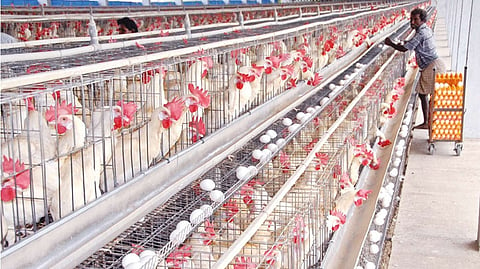

COIMBATORE: Egg exports from the poultry hub of Namakkal to gulf countries have got a boost as global inflation following the Russia- Ukraine war has made imports from Turkey a costly affair.
A sharp increase in prices of eggs from Turkey in the international market has turned out to be a blessing in disguise for poultry farmers in Namakkal as importing nations like Dubai, Qatar and Oman have begun to explore alternative markets.
“A box of 360 eggs from Turkey, which was usually priced between $18 and $20, had gone up to $36 last month. The production cost of eggs escalated steeply there due to the rise in the price of poultry feed and raw materials in the aftermath of the Russia-Ukraine war. As a box of eggs from Namakkal is priced less than $30, the buyers have begun to shift priority on us,” said K Singaraj, president of Tamil Nadu Egg Poultry Farmers Association
Such changing market scenario has in turn scaled up demand for the export of Namakkal eggs.
“The total egg exports have gone up phenomenally from just 2.5 crore eggs per month including one crore eggs to Maldives and African countries to nearly 10 crore eggs last month alone. There is even a possibility for exports to go up further as the world cup football in Qatar has also pushed up demand for eggs. However, export to Maldives and African countries continue to remain the same at one crore,” he said
“Infact, the Middle East nations were not new markets and till some six years ago, a large volume of eggs were sent there from Namakkal. Exports which should have increased over a period had rather dwindled due to various issues including bird flu,” said Vangili Subramanian, president, of Tamil Nadu Egg Marketing Society.
Of the total 18 crore eggs produced by India daily, the poultry hub of Namakkal alone contributes a significant share of six crore eggs.
“Poultry farmers here have the capacity to escalate production to meet any demand from the export market. Efforts have also been made to improve the production standards to match the norms stipulated by European nations, where brown eggs are prevalent. But it could be possible only with some support from the central government due to strict licensing norms,” said S Ram Kumar, another exporter.
To further scale up egg exports, the poultry farmers have been seeking separate zoning of each state.
“Though there has been no outbreak of bird flu in Namakkal, the poultry farmers have borne the brunt as the entire nation is treated as one zone by importing nations. An outbreak of avian influenza in Kerala or anywhere else takes a toll on Namakkal. Hence, we were demanding to declare Tamil Nadu as one zone,” said egg exporters.
Increasing cost of poultry feed bogs down farmers in dist
Poultry farmers in Namakkal had met with severe losses due to production costs staying higher than the selling price of eggs over the last two years in the domestic market.
After remaining drastically low, the procurement cost of eggs increased nominally just a few days ago to Rs 5.20 paise per egg in the domestic market. Still it doesn’t fetch enough profit as the production cost of an egg is pegged at Rs 4.70 paise.
Last month, the average procurement price was Rs 4.20 paise, when farmers faced a loss of Rs 50 paise per egg. Before that, the loss was around Rs one rupee per egg. It may take up to two years to overcome the loss faced by poultry farmers. Exports may have picked up, but the farm gate price of eggs in the domestic market is yet to gain satisfactory levels,” said Vangili Subramanian, president of Tamil Nadu Egg Marketing Society.
In the last three years, the average procurement price of eggs has increased gradually from Rs 3.83 paise in 2020, Rs 4.16 paise in 2021 and Rs 4.52 in 2022.
An increase in the cost of poultry feed is attributed to be a major reason behind such loss. “The cost of eggs continues to be drastically low as compared to poultry feed, which has shot up by around 40 per cent over the last year. Soya, which was sold at around Rs 30 per kg, increased to Rs 80 and above, before coming down a bit now to nearly Rs 60. Medicine prices have also increased sharply,” say farmers.
Poultry farmers are however hopeful that demand for eggs may go high in the next three months. “With the start of the winter season, egg consumption is likely to shoot up in the next three months thereby increasing demand in the domestic market. The bird flu outbreak in Kerala has not had its impact on the local markets,” said H Sivaram, a poultry farmer.
Visit news.dtnext.in to explore our interactive epaper!
Download the DT Next app for more exciting features!
Click here for iOS
Click here for Android